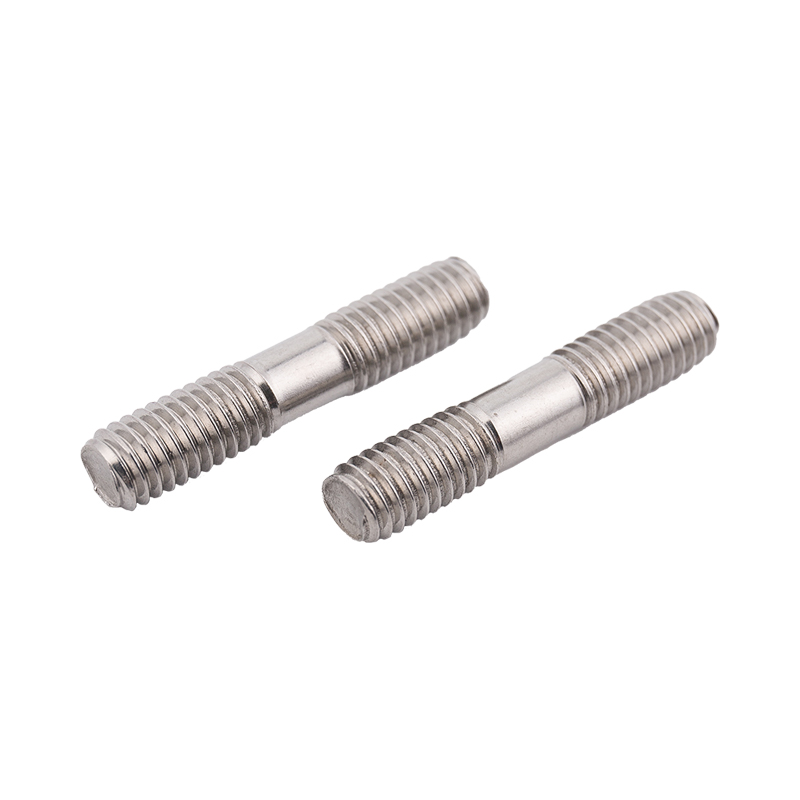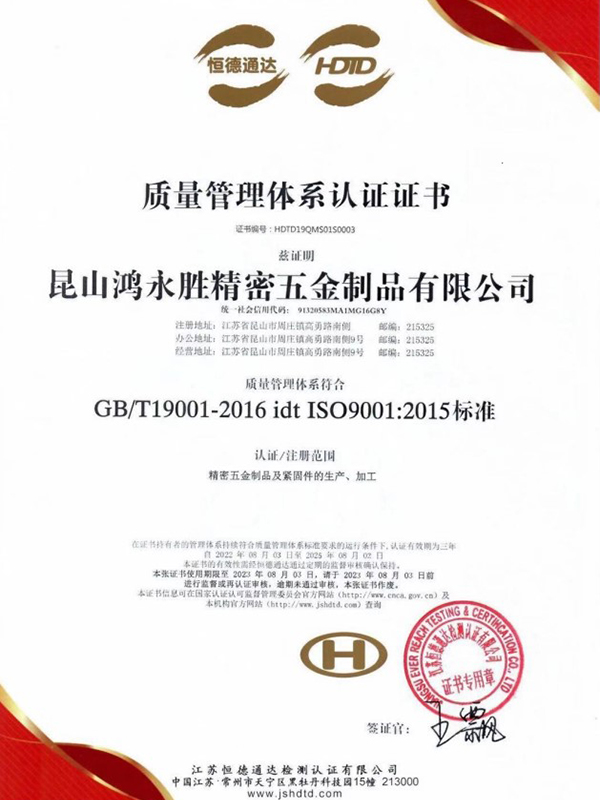Carbon Steel Bolt Supplier Guide: What Buyers Should Look For Selecting the right supplier for carbon steel bolts affects product performance, safety, and long-term cost. This guide breaks down the p...
READ MOREThe company has obtained two quality system management certificates of ISO9001:2015 and IATF16949:2016.
At present, the company has been for Japan, Sweden, the United States, Singapore, Malaysia, Hong Kong and the Pearl River Delta and many other customers to provide services, now the main customers are: Japan Sharp (SHARP), Japan SMC, Japan Panasonic (Panasonic), the Swedish automobile VOVOL, etc., all the fixed assets investment of more than 30 million dollars, welcome friends from all walks of life to the factory to visit, study, consulting and come! We welcome friends from all walks of life to visit our factory, investigate, consult and come to us for sample processing.
We are looking forward to establishing a good business partnership with you with mutual trust and reciprocity!
-
-
Introduction: The Foundation of Mechanical Systems In the intricate world of modern manufacturing and engineering, machined parts form the fundamental building blocks of virtually every mechanical sys...
READ MORE -
Why Structural Integrity Matters In construction, machinery, and other industrial applications, structural integrity is crucial for safety, performance, and longevity. One of the key elements in ensur...
READ MORE -
Introduction to Stainless Steel Fasteners Stainless steel fasteners are widely used in construction, machinery, and industrial applications due to their corrosion resistance and durability. Among them...
READ MORE
How to control the preload force of studs during installation?
In our daily life, studs are an indispensable part of mechanical connections. Whether in automobiles, construction or electronic equipment, studs play a key role in connecting and fastening. However, the connection quality of studs is often affected by pre-tightening force. Too large or too small pre-tightening force may lead to a series of problems. So, how to control the pretightening force when installing studs?
First, we need to understand what preload is. Pre-tightening force is the compressing force generated between the bolt and the connected parts through the tightening torque or tightening force during the tightening process of the bolt. The size of the pre-tightening force directly affects the firmness and reliability of the bolt connection.
Next, we will introduce several commonly used methods to control stud preload:
Select appropriate bolts and nuts: this is the basis for controlling preload. In high temperature or corrosive environments, materials with good heat and corrosion resistance should be selected. In addition, the matching accuracy of bolts and nuts is also very important to ensure a tight fit of the connectors.
Use the torque control method: The torque control method is a commonly used method to control the bolt pretightening force. By measuring the torque exerted on the bolt, the amount of preload force can be indirectly deduced. This method requires selecting a suitable torque wrench and setting the appropriate torque value based on the specification and material of the bolt. At the same time, attention should also be paid to controlling the tightening speed to avoid inaccurate pretightening force caused by too fast or too slow.
Use the elongation control method: The elongation control method is a more precise way to control the bolt pretightening force. It directly controls the amount of pre-tightening force by measuring the elongation of the bolt during tightening. This method requires measuring the initial length of the bolt and the length after tightening, and calculating the pretightening force based on the elongation calculation formula. This method requires higher operating skills and measuring equipment, but can obtain a more accurate preload control effect.
Use special washer method: Some specially designed washers, such as disc spring washers or elastic washers, can provide a certain elastic force after the bolt is tightened, thereby helping to control the preload force. This method is suitable for some occasions that have strict requirements on preload force.
In addition, inappropriate preload force can cause a series of adverse consequences. If the threaded fasteners are over-tightened, that is, the pre-tightening force is too large, the bolts may be twisted off, the connecting parts may be crushed, stuck, twisted or broken, or the thread teeth may be sheared and tripped. If the pre-tightening force is insufficient, the connected parts will slip, causing the connected parts to be dislocated, skewed, wrinkled, or even the fasteners to be sheared; insufficient pre-tightening force will cause joint surface leakage, such as pressure pipe leakage and engine leakage. The air may even cause the two connected parts to separate. Insufficient pre-tightening force will also cause strong lateral vibration, causing the nut to loosen.
Therefore, when installing studs, we need to choose the appropriate method to control the preload force according to the specific application scenarios and requirements, and strictly follow the operating procedures to ensure the firmness and reliability of the stud connection. At the same time, we also need to regularly inspect and maintain stud connections to detect problems in time and deal with them to extend the service life of the studs and improve the reliability of the equipment.
What are the structural characteristics of studs?
Studs, as fasteners widely used in the industrial field, play an important role in mechanical connections with their unique structures and functions. This article will provide a detailed explanation of the structural characteristics of studs to help readers better understand this commonly used part.
Thread design at both ends: The most significant structural feature of the stud is that both ends are processed with threads. This design allows the studs to be screwed directly into the prefabricated holes of the connector without the need for nuts, which is very suitable for situations where one side is closed or it is difficult to install the nut from the other side.
Diverse material selection: Studs can be made of a variety of materials according to usage requirements, including but not limited to carbon steel, alloy steel, stainless steel, etc. The choice of material directly affects the mechanical properties of the stud, such as strength, corrosion resistance and temperature resistance.
Strength grade division: Similar to bolts, studs also have different strength grades. These grades are usually determined based on the tensile strength and yield strength of the stud material. High-strength studs are often heat treated to improve their mechanical properties.
Wide range of application scenarios: Due to their simple structure and easy installation, studs are widely used in various industrial fields, such as machinery manufacturing, building structures, bridge engineering, automobile industry, etc. Studs provide an effective solution where connections need to be secured from both sides.
Importance of Preload: When installing studs, it is crucial to control the preload. Appropriate preload can ensure the reliability and stability of the connection. Too small a pre-tightening force may cause the connection to loosen, while too large a pre-tightening force may cause damage to the connection or breakage of the stud.
Installation and Maintenance: Installation of studs usually requires specialized tools and certain skills. After installation, regular inspection and maintenance are also essential to ensure the long-term stability of the connection.
Anti-loosening design: In order to prevent studs from loosening during use, various anti-loosening designs are often used, such as thread locking glue, special stud head designs or the use of anti-loosening washers.
The structural characteristics of studs make them an indispensable fastener in industrial connections. Understanding the structure and function of studs is critical for engineers when designing and selecting fasteners. With the application of new materials and new technologies, the performance and application scope of studs will continue to expand, making greater contributions to industrial development.



 русский
русский Español
Español


